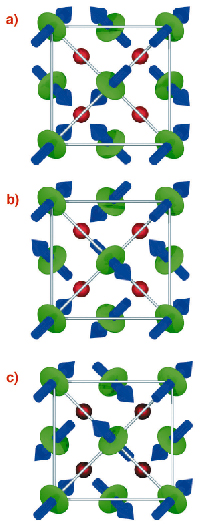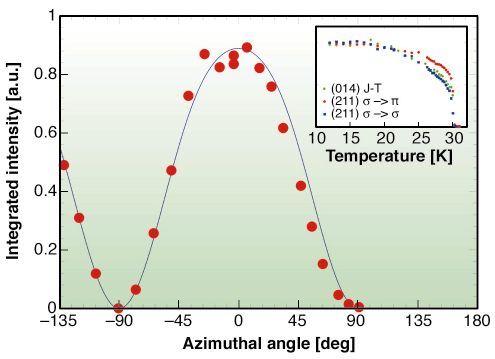- Home
- Users & Science
- Scientific Documentation
- ESRF Highlights
- ESRF Highlights 2005
- X-ray Absorption and Magnetic Scattering
- The Mysteries of Low-temperature Ground States of Actinide Oxides Resolved by Synchrotron Experiments
The Mysteries of Low-temperature Ground States of Actinide Oxides Resolved by Synchrotron Experiments
The discovery at the ESRF in 2002 [1] of quadrupole ordering in neptunium dioxide opened a new chapter in the understanding of the low-temperature ground states of actinide oxides. We concentrate in this report on the solid solutions (U1-xNpx)O2, all with the simple cubic CaF2 crystal structure and which have been studied for many years. The phenomena found at 25 K in NpO2 (x = 1) is that the 5f charge distribution develops an anisotropic component that exhibits long-range ordering at T0 = 25 K. This is known as the ordering of the charge quadrupoles.
The experiments, carried out on beamline ID20, consist of tuning the photon energy to the actinide M absorption edge (at which photon energy core 3d electrons are promoted to the partially occupied 5f valence states), and then, once the repeat (wavevector) of the anisotropic charge distribution is known, one measures the azimuthal distribution of the scattered resonant X-ray intensity. This intensity distribution is related to the symmetry of the 5f anisotropic charge. The experiments were performed on single crystals prepared and mounted at the Institute of Transuranium Elements in Karlsruhe, Germany.
NpO2 has pure quadrupole ordering, with no measurable dipole moment. In 2003 experiments were performed on a single crystal with x = 0.25 [2]. Dipole ordering was found on both the U and Np ions, and quadrupolar ordering was also found associated with both ions. However, these were different from those in pure NpO2. Whereas a longitudinal configuration was found for x = 1 (NpO2), the x = 0.25 sample was found to have a transverse configuration. The difference between these configurations is shown in Figure 123.
 |
|
Fig. 123: Schematic representation of triple-k magnetic and electric-quadrupole ordering within the a-b plane for the single longitudinal (a) and two transverse (b,c) modes. The magnetic (dipole) moments are represented by blue arrows whereas the electric-quadrupole moments are shown as the green ellipsoids. The red spheres represent oxygen atoms. |
The understanding of these different configurations then allowed an experiment to be performed in 2004 on a single crystal of UO2 (x = 0). The azimuthal dependence of the intensity from the (112) reflection in UO2 is shown in Figure 124, together with the predictions for a transverse configuration. Shown also in Figure 124 is the temperature dependence of both the magnetic dipole, electric-quadrupole and the internal distortion of the oxygen cage. The complication in UO2 is that both dipole ordering and an internal distortion of the oxygen atoms due to the quadrupole ordering are present; these have contrived to make it difficult to observe the quadrupole ordering in UO2 directly, although such ordering was predicted almost 40 years ago [3], and the oxygen displacements reported 30 years ago [4].
 |
|
Fig. 124: UO2. Integrated intensity as a function of azimuthal angle for the (112) superstructure reflection in the sigma–sigma polarisation channel (open circles). The line is a fit to the model for quadrupolar ordering (see text for details). In the model there is an incoherent superposition of the two transverse modes. The inset shows the temperature dependence of the integrated intensities of the (112) reflection in both the |
These experiments also suggest a qualitative explanation of the unusual behaviour [5] of the mixed oxides with 0.40 < x < 0.80. In this region there is competition between the longitudinal and transverse quadrupole ordering, resulting in quadrupolar frustration and only short-range dipole and quadrupole ordering. Experiments to detect such effects are planned.
References
[1] J.A. Paixão et al., Phys. Rev. Lett. 89, 187202 (2002).
[2] S.B. Wilkins et al., Phys. Rev. B 70, 214402 (2004).
[3] S.J. Allen, Phys. Rev. 167, 492 (1968).
[4] J. Faber et al., Phys. Rev. Lett. 35, 1770 (1975).
[5] A. Boeuf et al., Europhys. Lett. 3, 221 (1987).
Principal publication and Authors
S.B. Wilkins (a,b), J.A. Paixão (c), R. Caciuffo (a), C. Detlefs (b), J. Rebizant (a), and G.H. Lander (a), Submitted.
(a) European Commission, Joint Research Centre, Institute for Transuranium Elements, Karlsruhe (Germany)
(b) ESRF
(c) Physics Department, University of Coimbra (Portugal)



